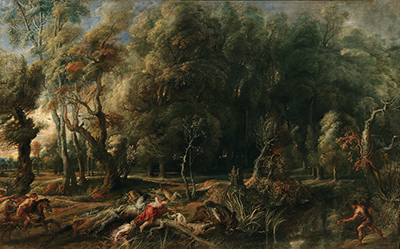Peter Paul Rubens, the great Flemish artist and grandmaster of Baroque-style painting, excelled in mythological and Biblical scenes. He was versatile, though, and landscape and pastoral scenes also feature in his body of work.
This is a landscape with a mythological scene added, almost as an afterthought. In answer to what's a Baroque-style painting, we can say that it features rich colours, drama, bright light and murky shadows. This painting shows us all of those. We note the grand, imposing forest, with its cathedral-like dignity. We see bright sunlight streaming in.
We see shadows lurking at the back, beyond the trees. We see drama as the hunt for the Calydonian Boar comes to its zenith. Atalanta, her would-be lover Meleager, with some support from Castor and Pollux, are about the kill the boar. This painting was created by Rubens in 1635.
This was towards the end of his life. Yet it doesn't seem to be the work of a fading artist. Rather, it appears to be the work of a master painter at the height of his powers. What's probably most remarkable about the painting is the fact that even though the name suggests that this is, in fact a scene from Greek mythology, it's a landscape first and foremost.
The figures of the mythological story sit at the bottom of the picture. You could almost miss them if you didn't know they were supposed to be there. The imposing forest is what dominates the painting. The landscape is the main part of the picture. The mythology is incidental.
About the Artist
Peter Paul Rubens was born in Germany in 1577 and later moved to Belgium, where he lived till his death in 1640. Not only a famous painter, he was also a diplomat. He's remembered for being an avid collector of books and art. Apart from excelling in painting in Baroque style, he's known for celebrating the female form in all its fecundity and desirability.
The adjective 'Rubinesque' is attributed directly to his work on the female form. Peter Paul Rubens was a balanced man who worked hard and also didn't forget to take care of himself. He would rise in the early hours of the morning and do his work. He would stop working at 5 pm and ride for a while to maintain physical fitness. He continued to learn and perfect his craft to the end, remaining ever-youthful and busy.




